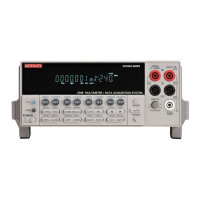Voltage connections (DC or AC) B-10
Wire dressing B-7
Wiring procedure B-6
Monitor channel 7-18
Monitor scan example 7-37
Multiple channels
Control commands 2-20
Controlling 2-17
Operation 2-16
Anomalies 2-22
mX+b (math function) 5-9
Configuration 5-9
Rel 5-10
Setting units 5-14
N
Noise
Johnson noise equation E-5
Lowest settings 4-8
Source resistance E-5
vs. speed characteristics 4-8
NPLC setting 4-9
O
Offset-compensated ohms 3-24, 3-25, 3-26,
3-27, 3-28, 3-32
Enabling/disabling 3-24
Performing measurements 3-25
OPEN key 2-11, 2-19
Open thermocouple detector 3-41
OPEN: ALL 2-11, 2-19
OPEN: MULTI 2-19
Operation event status 11-14
Options 1-3
Output trigger 7-10, 8-6
P
Paired channels
see 4-wire functions
Percent (math function) 5-10
Configuration 5-10
Reference 5-14
Performance considerations 3-4
Plug-in switching modules 1-3, 1-7
Power module 1-14, 1-15
Power switch 1-11
Power-up 1-15
Sequence 1-17
Primary address
Setting 10-4
Program message terminator (PMT) 10-16
Program messages 10-15
Programming syntax 10-11
Pseudocards 1-9, 2-5, 10-2
Q
Questionable event status 11-17
Queues 11-2, 11-22
Clearing 11-4
Error queue 11-22
Output queue 11-22
Quick start 1-1
Exercises 1-26
R
Rack mount kits 1-6
Radio frequency interference E-6
Range 4-2
Auto ranging 4-3, 4-5
Commands 4-4
Keys 1-12
Manual ranging 4-3, 4-5
Measurement 4-2
Programming examples 4-5
Remote programming 4-4
Scanning 4-3
Range, Digits, Rate, Bandwidth, and Filter 4-1
Rate 4-8
Aperture 4-12
Bandwidth 4-12
Bandwidth conflict error 4-12
Commands 4-10
Programming examples 4-13
Remote programming 4-10
Scanning 4-10
Settings 4-9
RATE key 4-8
Ratio 5-16
Basic operation 5-17
Channel pairing 5-16
Commands 5-19
DCV 5-17
Delay 5-19
Enabling/disabling 5-19
Programming examples 5-20
Remote programming 5-19
Scanning 5-18
Ratio and channel average
delay 5-19
Reading count 7-9
Readings
Maximum 4-2
Recall while storing 6-12
Recalling 6-6
Storing 6-6

